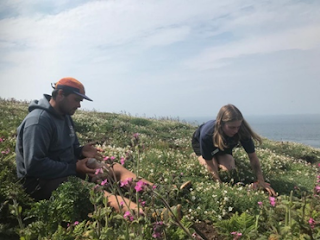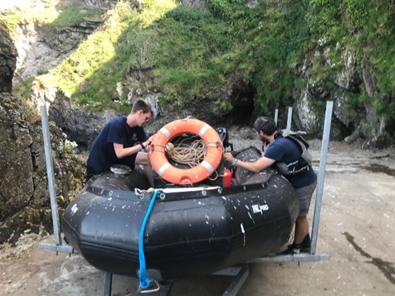If you were on the island in May or June, you may have noticed our staff carrying out lots of land and boat surveys – that’s because it was seabird counting season. With the aid of some photos, we thought it would be nice to explain a little more about what the survey work entailed. Our Puffin counts were completed in March (see blog post here) so we were focusing on Guillemots, Razorbills, Fulmars, Kittiwakes and Manx Shearwaters.
Guillemots
and Razorbills
Our counts
for Guillemots and Razorbills started on 25th May and had to be
completed by 11th June. The island is split into 45 sections of
coast, each of which has to be counted twice. Every Guillemot and Razorbill in
suitable breeding habitat (not sitting on the tideline and clearly on nest
sites) are counted.
 |
| Hannah and Lisa counting Guillemots and Razorbills |
 |
| A Guillemot (bottom) and pair of Razorbills with a chick (centre) |
Fulmars
and Kittiwakes
The counts
for these birds start on the 1st June to time with their incubation,
though the rest of the methodology is the same.
Kittiwakes
are found in dense colonies. They are medium-sized gulls with black legs and
wingtips, a prominent dark eye and yellow bill. Fulmars, who are members of the
Albatross family despite resembling gulls, have broad stiff wings and a
prominent “tube-nose” capable of spraying an oily substance at predators when
threatened.
To monitor
the Manx Shearwater numbers, we have a series of 100m2 circular
plots around the island. As this starts on 1st June, Manx
Shearwaters should be on their nests incubating during the day. As a team, we
move through the plots, playing Manx Shearwater calls down every burrow we find
– the Manxies will usually call back to the recording if they’re in there. By
working out how many burrows in a plot are occupied, we can scale this up to
get an estimate of island numbers.
 |
| Rob, Hebe, Erin and Lotti putting ropes to mark the Manx Shearwater area |
 |
| Leighton and Erin checking burrows |
 |
| Will playing a Manx Shearwater call down a burrow |
From all of
this data, we can calculate the populations of these five seabird species on
Skomer. It tells us how our seabirds are doing and informs our conservation
management for the future.
We are
incredibly grateful to all our staff, researchers and weekly volunteers for
their help in completing this work. We are especially thankful to Hebe, our
seabird volunteer, Erin and Lotti, our long-term volunteers and Issy, our 2022
seabird volunteer, for their tireless work on boat and land surveys.
 |
| Hebe on our boat |
Until next
year, seabird counts!
This
project is funded by the Nature Networks Programme. It is being delivered by
the Heritage Fund, on behalf of the Welsh Government. We are very grateful, as this funded the boat
repairs, boat clothes, Rob’s powerboat course and whole island seabird counts.
 |
| Rob modelling some of the new boat clothes provided by the funding. |






No comments:
Post a Comment